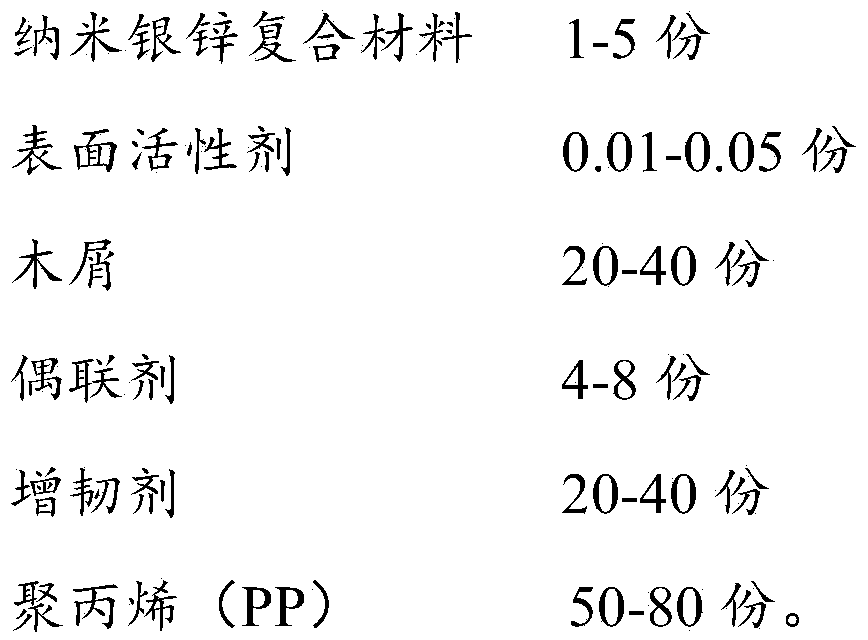Environment-friendly nano antibacterial wood plastic composite and preparation method thereof
An antibacterial wood and nano technology, applied in the field of wood-plastic materials, can solve the problems of decreased mechanical properties, poor compatibility, easy breeding of bacteria, etc., and achieve the effect of improving antibacterial and antifungal properties.
- Summary
- Abstract
- Description
- Claims
- Application Information
AI Technical Summary
Problems solved by technology
Method used
Image
Examples
preparation example Construction
[0043] A preparation method of an environment-friendly nano antibacterial wood-plastic material, comprising the following steps:
[0044] (1), putting the nano-silver-zinc composite material, surfactant and water weighed according to the above-mentioned formula ratio into a grinder, and grinding for 8 hours to obtain a uniformly dispersed nano-silver-zinc composite aqueous solution;
[0045] (2) Pretreatment: Pour the above-mentioned nano-silver-zinc composite aqueous solution and coupling agent into wood chips, stir evenly, and dry at a constant temperature of 60°C to obtain modified wood chips;
[0046] (3), compatibilization treatment: pour the above-mentioned modified sawdust and the toughening agent into the internal mixer together to granulate, and obtain the toughened modified material of sawdust;
[0047] (4) Extrusion: After mixing the above-mentioned wood chip toughening modified material and polypropylene (PP) evenly, extrude with twin-screws, and the extrusion temp...
Embodiment 1
[0058](1) Components and dosage of nano-silver-zinc composite materials
[0059]
[0060] (2) Components and dosage of environmentally friendly nano-antibacterial wood-plastic materials
[0061]
[0062]
[0063] The prepared environment-friendly nano antibacterial wood-plastic material has undergone relevant tests on mechanical properties and antibacterial and antifungal properties, and the test results of various indicators are shown in Table 1.
[0064] Table 1 Test results of environmentally friendly nano-antibacterial wood-plastic materials
[0065]
[0066] The test results show that the prepared environmentally friendly nano-antibacterial wood-plastic material has good mechanical properties, antibacterial and anti-mildew properties, is not easy to be eaten by insects, and has a long service life.
Embodiment 2
[0068] (1) Components and dosage of nano-silver-zinc composite materials
[0069]
[0070] (2) Components and dosage of environmentally friendly nano-antibacterial wood-plastic materials
[0071]
[0072] The prepared environment-friendly nano antibacterial wood-plastic material has undergone related tests on mechanical properties and antibacterial and antifungal properties, and the test results of various indicators are shown in Table 2.
[0073] Table 2 Test results of environmentally friendly nano-antibacterial wood-plastic materials
[0074]
[0075] The test results show that the prepared environmentally friendly nano-antibacterial wood-plastic material has good mechanical properties, antibacterial and anti-mildew properties, is not easy to be eaten by insects, and has a long service life.
PUM
 Login to View More
Login to View More Abstract
Description
Claims
Application Information
 Login to View More
Login to View More - R&D
- Intellectual Property
- Life Sciences
- Materials
- Tech Scout
- Unparalleled Data Quality
- Higher Quality Content
- 60% Fewer Hallucinations
Browse by: Latest US Patents, China's latest patents, Technical Efficacy Thesaurus, Application Domain, Technology Topic, Popular Technical Reports.
© 2025 PatSnap. All rights reserved.Legal|Privacy policy|Modern Slavery Act Transparency Statement|Sitemap|About US| Contact US: help@patsnap.com



